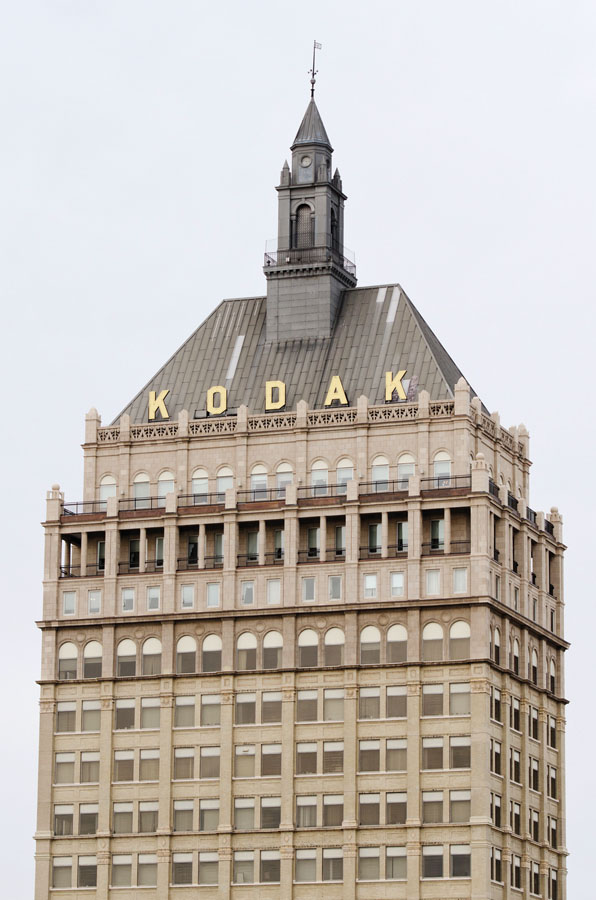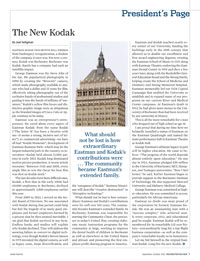President's Page
 (Photo: Adam Fenster)
(Photo: Adam Fenster)Eastman Kodak this month will emerge from bankruptcy reorganization, a shadow of the company it once was. For over a century, Kodak was Rochester; Rochester was Kodak. Rarely has a company had such an indelible impact.
George Eastman was the Steve Jobs of his day. He popularized photography in 1900 by creating the “Brownie” camera, which made photography available to anyone who had a dollar and 15 cents for film, effectively taking photography out of the exclusive hands of professional studios and putting it into the hands of millions of “amateurs.” Kodak’s yellow film boxes and distinctive graphic image were as ubiquitous as the branded images of Coca-Cola or Apple continue to be today.
Eastman was an entrepreneur’s entrepreneur. He cared about every aspect of Eastman Kodak: from the name Kodak (“The letter ‘K’ has been a favorite with me—it seems a strong, incisive sort of letter”); to commercial advertising—we have all had “Kodak Moments”; development of Eastman Business Park—which may be the largest industrial park in the country; to innovation—Kodak held almost 11,000 patents in early 2013. Kodak long dominated motion picture production. A recent article recounts: “Between 1928 and 2008, every single film to win the Oscar for best film was shot on Kodak stock.”
The last decades have been difficult ones. Kodak, a firm that in the early 1980s had 60,000 employees in Rochester, declined to approximately 3,500 employees earlier this year.
From 2009 to 2013, I served on the Kodak Board of Directors. No one associated with Kodak during that period could help but feel the tragedy of so many good employees and former employees harmed by a process that by then seemed inevitable. I am glad that Kodak survived in any form. Endless books and studies will explain why Kodak declined. They will address the seeming failure to convert to digital technology, even though Kodak’s Steven Sasson in 1975 invented the digital camera, as well as legacy costs, inept diversification, and the “smugness of Kodak.” Business historians will describe “creative destruction” or “disruptive technology.”
What should not be lost is how extraordinary Eastman and Kodak’s contributions were for well over 100 years. The community became Eastman’s extended family. In Rochester, Eastman was responsible for starting the Community Chest, the precursor to today’s United Way, creating elaborate music instruction programs for the community at large, working to improve the dental health of children in Rochester as well as elsewhere in the United States and abroad, and pioneering the first employee profit-sharing program in America.
Eastman and Kodak touched nearly every corner of our University, funding the buildings early in the 20th century that allowed us to double our enrollment and first award engineering degrees; creating the Eastman School of Music in 1921 along with Eastman Theatre; endowing the Eastman Dental Center in 1919 and then a few years later, along with the Rockefeller General Education Board and the Strong family, helping create the School of Medicine and Dentistry and Strong Memorial Hospital. Eastman memorably led our 1924 Capital Campaign that enabled the University to establish and to expand many of our programs on our current River and Medical Center campuses. At Eastman’s death in 1932, he had given more money to the University of Rochester than had been received by any university in history.
This is all the more remarkable for a man who dropped out of high school at age 14.
I am proud that during my time here we belatedly installed a statue of Eastman on the Eastman Quadrangle and named the main performance hall in Eastman Theatre as Kodak Hall.
George Eastman’s ultimate legacy in part will be higher education. He came to believe: “The progress of the world depends almost entirely upon education.” On one day in 1924, Eastman pledged $30 million to the University of Rochester, MIT, Hampton, and Tuskegee universities. “Now I feel better,” he said. Earlier Eastman began to provide support to the Rochester Institute of Technology. He also supported Howard University and Meharry Medical College.
George Eastman was committed to higher education. He was committed to access, particularly for African Americans.
Eastman no doubt was most proud of the corporation he formed, Eastman Kodak. He was an unassuming man with a “success complex,” who achieved nearly every corporate, civic, and educational goal he sought. Eastman Kodak will be remembered for its remarkable 132-year history—extraordinarily long for a top-flight business corporation—as well as the company’s remarkable loyalty to its hometown.
Let me bid farewell to the original Eastman Kodak. Long live the new Kodak.

